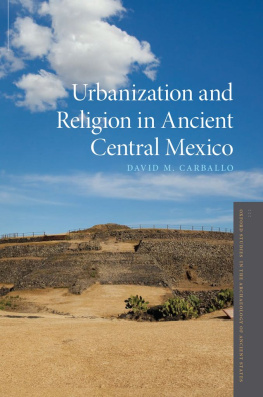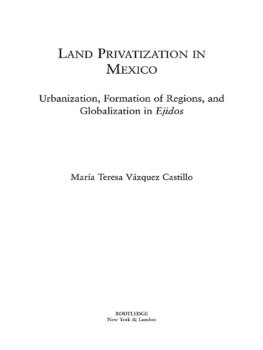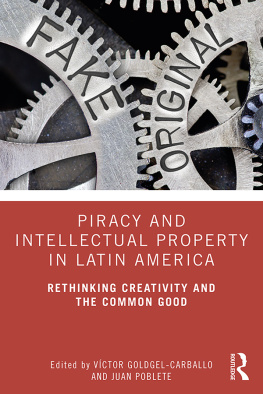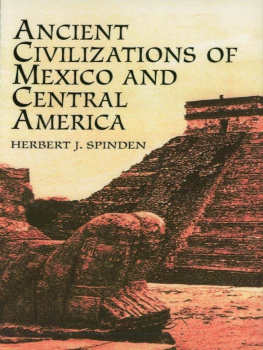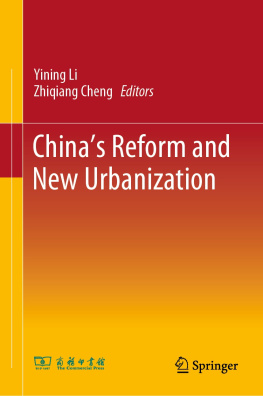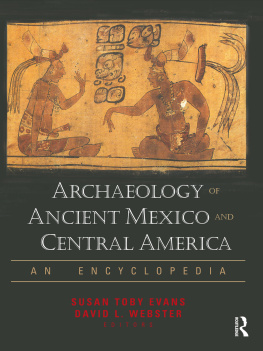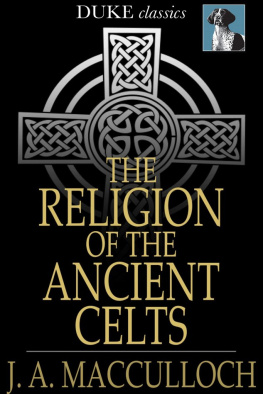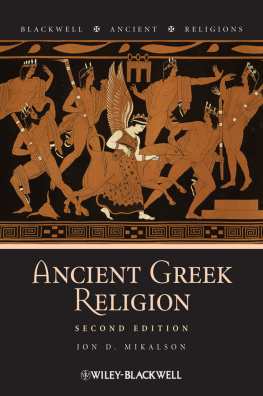David M. Carballo - Urbanization and Religion in Ancient Central Mexico
Here you can read online David M. Carballo - Urbanization and Religion in Ancient Central Mexico full text of the book (entire story) in english for free. Download pdf and epub, get meaning, cover and reviews about this ebook. year: 2015, publisher: OUP Premium, genre: Religion. Description of the work, (preface) as well as reviews are available. Best literature library LitArk.com created for fans of good reading and offers a wide selection of genres:
Romance novel
Science fiction
Adventure
Detective
Science
History
Home and family
Prose
Art
Politics
Computer
Non-fiction
Religion
Business
Children
Humor
Choose a favorite category and find really read worthwhile books. Enjoy immersion in the world of imagination, feel the emotions of the characters or learn something new for yourself, make an fascinating discovery.
- Book:Urbanization and Religion in Ancient Central Mexico
- Author:
- Publisher:OUP Premium
- Genre:
- Year:2015
- Rating:5 / 5
- Favourites:Add to favourites
- Your mark:
- 100
- 1
- 2
- 3
- 4
- 5
Urbanization and Religion in Ancient Central Mexico: summary, description and annotation
We offer to read an annotation, description, summary or preface (depends on what the author of the book "Urbanization and Religion in Ancient Central Mexico" wrote himself). If you haven't found the necessary information about the book — write in the comments, we will try to find it.
Urbanization and Religion in Ancient Central Mexico — read online for free the complete book (whole text) full work
Below is the text of the book, divided by pages. System saving the place of the last page read, allows you to conveniently read the book "Urbanization and Religion in Ancient Central Mexico" online for free, without having to search again every time where you left off. Put a bookmark, and you can go to the page where you finished reading at any time.
Font size:
Interval:
Bookmark:

Series Editors
Friederike Fless, Li Liu, Deborah L. Nichols, and D. T. Potts
This series explores the origins and dynamics of individual ancient states, from the Bronze Age in the Old World to the pre-contact empires in the New World. Each volume aims to present the most relevant and up-to-date archaeological evidence against the backdrop of complementary sources from a range of disciplines.
Urbanization and Religion in Ancient Central Mexico
DAVID M. CARBALLO
The Origins of Ancient Vietnam
NAM KIM
The Ancient Highlands of Southwest China
From the Bronze Age to the Han Empire
ALICE YAO

Oxford University Press is a department of the University of Oxford. It furthers the Universitys objective of excellence in research, scholarship, and education by publishing worldwide.
OxfordNew York
AucklandCape TownDar es SalaamHong KongKarachi
Kuala LumpurMadridMelbourneMexico CityNairobi
New DelhiShanghaiTaipeiToronto
With offices in
ArgentinaAustriaBrazilChileCzech RepublicFranceGreece
GuatemalaHungaryItalyJapanPolandPortugalSingapore
South KoreaSwitzerlandThailandTurkeyUkraineVietnam
Oxford is a registered trademark of Oxford University Press in the UK and certain other countries.
Published in the United States of America by
Oxford University Press
198 Madison Avenue, New York, NY 10016
Oxford University Press 2016
All rights reserved. No part of this publication may be reproduced, stored in a retrieval system, or transmitted, in any form or by any means, without the prior permission in writing of Oxford University Press, or as expressly permitted by law, by license, or under terms agreed with the appropriate reproduction rights organization. Inquiries concerning reproduction outside the scope of the above should be sent to the Rights Department, Oxford University Press, at the address above.
You must not circulate this work in any other form and you must impose this same condition on any acquirer.
Cataloging-in-Publication data is on file at the Library of Congress
ISBN 9780190251062
eISBN 9780190493493
For Daniel and Tony,
our atl tlachinolli
Figures
Tables
PERCHED IN A CAF BALCONY atop Mexico Citys Plaza de La Constitucin, or Zcalo, in the geographical and spiritual heart of the country, one can order an espresso or tequila and contemplate layers of urbanism. Vendors, tourists, and often protesters move below in the large open plaza that is the site of exuberant political, religious, and cultural spectacles for one of the largest cities of the modern world. Ringing the plaza are the sixteenth- and seventeenth-century structures of the capital of New Spain, La Ciudad de Mxico, including the Cathedral and the National Palace. Many of these structures incorporate the volcanic stone blocks of the earlier Aztec imperial capital, Mexico-Tenochtitlan, dismantled by Hernn Corts and the Spanish conquistadors. The dual appellation of the former capital couples place-names associated with Huitzilopochtli, patron god of the Mexicathe dominant ethnic group of the Aztec empireand Tlaloc, one of the longest lived and most important gods of central Mexico, associated with storms, water, and agricultural fertility (:186187). These two deities were venerated in the Huey Teocalli (great gods house), commonly known by the Spanish term Templo Mayor, whose fourteenth- through sixteenth-century foundations are visible east of the Cathedral. Mexico-Tenochtitlan and other teeming Aztec cities encountered by Corts and the conquistadors served as the centers of ritual spectacles for a religious system that to Spanish eyes was simultaneously baffling, terrifying, and remarkable.
Although Mexica-Aztec accounts of the founding of the city emphasize its abandoned state prior to the urban transformation they initiated, archaeological evidence attests to earlier occupation on the island that Tenochtitlan and its sister-city Tlatelolco eventually grew to cover and expand through wetland-reclamation projects. By moving ones gaze from the plaza to the near horizons, still more ancient layers of urbanism are visible on a clear day. Nestled at the feet of majestic mountain ranges are the ruined cities of Teotihuacan to the northeast, which had its apogee during the Classic period (ca. A.D. 100550), and Cuicuilco to the southeast, which had its apogee during the Formative period (ca. 600 B.C.A.D. 100). Beyond the mountains in the adjacent regions of central Mexico are other Formative and Classic period centers that attest to the initial pulses of urbanization in the area as well as the crystallization and formalization of certain elements of a definable urban and religious tradition.
This book is about layers of urbanism. It moves through them in an attempt to illuminate the less studied yet seminal interval represented by central Mexicos later Formative period, including its cycles of urbanization, and the entangled creation of cities and religion. I strive to provide some degree of synthesis to this period; to highlight the urban and religious institutions that emerge, endure, or disappear over time; and suggest reasons for similarities and differences across space and time that may also be applicable, in general terms, to archaeological sequences from other parts of the world. These goals increase in their ambition, and any successes are directly attributable to the immense assistance I had from friends, family, and colleagues.
The mix of synthesis and independent research represented in this book was made possible through the gracious contributions of numerous institutions and individuals. Being the central case study, and what motivated my interest in examining the intersections between urbanization and religion in the first place, research at La Laguna was enabled by funding from the National Science Foundation (BCS-0941278), the National Geographic Society (CRE-8057-06, CRE-8634-09), a collaborative research grant from UCMEXUSCONACYT (awarded jointly with Luis Barba), the Foundation for the Advancement of Mesoamerican Studies, Inc. (#05018), and the College of Arts and Sciences at Boston University. I am very grateful for the support offered by these institutions as well as for the permissions and administrative assistance offered by the Consejo de Arqueologa of Mexicos Instituto Nacional de Antropologa e Historia (INAH), and by the Centro INAH Tlaxcala. For their warm hospitality I very sincerely thank the Gonzlez de Haro family of Ganadera La Laguna and the people of San Jos Laguna.
It has been a tremendous pleasure working on the archaeology of central Mexico for the last 15 years because of the collegiality and collaboration offered by other area specialists. Luis Barba served as co-director for the Proyecto Arqueolgico La Laguna during its last three seasons and he, Agustn Ortz, and Jorge Blancas helped develop a much richer geospatial understanding of the site. The genesis of the project lies in Aleksander Borejsza working there first as part of the UCLA project in central Tlaxcala, directed by Richard Lesure. Richard, Alex, and Isabel Rodrguez Lpez have contributed continually as field and lab companions and in the analysis of various materials that provide the backbone for chronology building and social interpretations of the Formative period in the region. A number of scholars working in adjacent regions have been generous in sharing their unpublished papers and photos or in guiding me to references; they include Anthony Aveni, George Cowgill, ngel Garca Cook, David Grove, Dan Healan, Kenneth Hirth, Shigeru Kabata, Carlos Lazcano Arce, Aurelio Lpez Corral, Leonardo Lpez Lujn, Donna Montero, Tatsuya Murakami, Deborah Nichols, Alejandro Pastrana, Patricia Plunket, Mari Carmen Serra Puche, Mike Smith, Saburo Sugiyama, Gabriela Uruuela, and Bill Woods. Others that have been sources of continued support to my work in Mexico include Monica Blanco Garca Mendez, Juan Ramrez Lima, Josefina Prez Prez, Raul Meja Martnez, my teammates in Union Laguna, Restaurante Nebraska, and Caf Tacuba.
Font size:
Interval:
Bookmark:
Similar books «Urbanization and Religion in Ancient Central Mexico»
Look at similar books to Urbanization and Religion in Ancient Central Mexico. We have selected literature similar in name and meaning in the hope of providing readers with more options to find new, interesting, not yet read works.
Discussion, reviews of the book Urbanization and Religion in Ancient Central Mexico and just readers' own opinions. Leave your comments, write what you think about the work, its meaning or the main characters. Specify what exactly you liked and what you didn't like, and why you think so.

